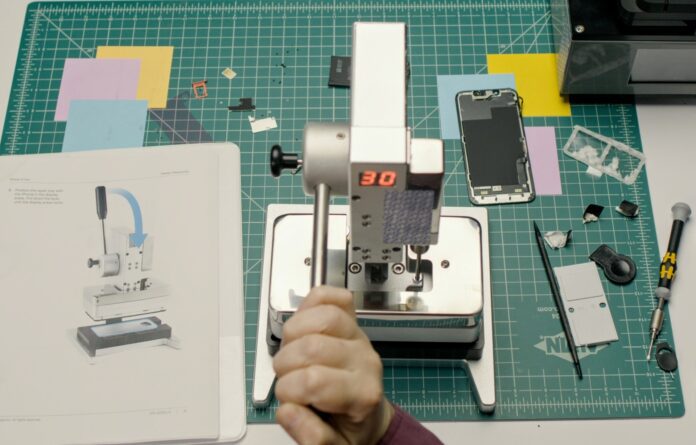It seems that Apple’s Do-It-Yourself Repair Program announced a few months ago is less exciting than hoped: the colleagues of The Verge they have had the opportunity to test it and the report of their experience is not necessarily entirely positive. The process is described as too cumbersome, complicated and expensive for the ultimate goal – saving money by doing things yourself.
In the meantime, it is important to understand how the initiative works in broad terms: the user buys the spare part he needs and rents specialized tools directly from Apple, which appear to be of extremely high quality. It includes a slot in which you place your iPhone to warm it in such a way as to soften the adhesive, an arm with suction cups to lift the display and a press to reposition the battery and the display with even pressure. The screwdriver with interchangeable tips is dynamometric. The entire kit takes up two trolleys and weighs a total of about 36 kg.
Some tools and procedures seem a bit of an exaggeration. Who would use a torque screwdriver in such a context (the magnetized tip would be much more convenient, which it isn’t), and not just use your fingers to secure the battery in place? Apple, among other things, requires the user to confirm that they have read the manual thoroughly by blocking the procedure until a six-digit code that appears in the manual itself is entered, and there are three pages of additional tools (including tweezers, very convenient to remove adhesive residues for example) which are recommended or otherwise not included in the kit, including a sand bucket to extinguish a fire in case the battery catches fire.
To make matters worse, once defective components have been replaced, even if they are original, they are apparently not recognized as such. The user must “authenticate” them, let’s put it this way: the process involves calling the specialized third-party company that takes care of the initiative and connecting the smartphone to a computer (with internet connectivity), which must be started in diagnostic mode. The firm then takes remote control and finally authenticates the components.
In addition to the component to be replaced, the user has to pay $ 50 for a week’s rental of the tools, but they also come temporarily withheld $ 1,200 on the credit card to cover any damage or delays in returning the tools. It is interesting to observe that the rental week starts from the moment the tools arrive at the user’s home, but it happened that the component to be replaced (in this specific case the battery of an iPhone 13 Mini) arrived two days later, thus reducing in significantly the window of time to proceed.
In short, it seems that Apple has launched a facade initiative: there is formally support for the right to repair, but it is implemented in a way that for the user there is no tangible advantage over going to official assistance– indeed, it is just the opposite. Let’s look at the cost of the component to be replaced: for the battery of the iPhone 13 Mini Apple asks $ 69, which is … exactly the same amount that you spend if you take the phone to an authorized center and have them do the work . So with Self-Service Repair, the user pays Apple $ 50 for the ability to do the job himself while taking on all the risks.
A pretty convincing demonstration of this theory is in the costs, which … should probably be much higher. Send two work trolleys for a total of about 36 kg from one part of the United States to the other is quite expensive, even with the obvious discounts guaranteed to a giant of the caliber of Apple, and it is very likely that the cost of the round trip will be higher (not a little) than the 50 dollars asked for. user for their rental. The Verge it is an infinitely smaller company than Apple, but a preliminary estimate indicated a cost of more than $ 200 (one way).
It is difficult to imagine that any user decides to try their hand at a delicate process (even with specialized tools) such as repairing their smartphone; that said, Apple’s willingness to develop a procedure as “foolproof” as possible is justifiable by calculating how much the right to repair argument has attracted and still attracts public attention. But looking at the procedure and considering that (most likely) it works at a loss it’s easy to imagine that Apple simply studied a way to show that he tried (and that it was the first to do so, by the way), but that ultimately users preferred to continue to contact official assistance.













